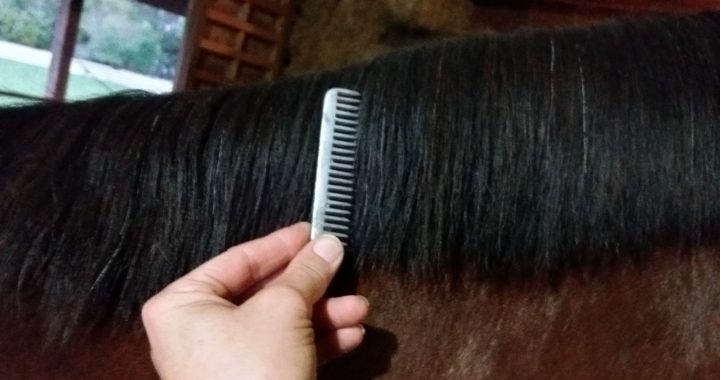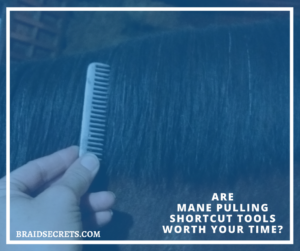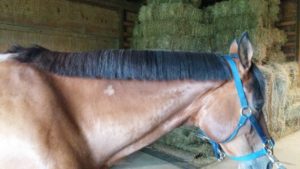[metaslider id=18]
MANE PULLING SHORTCUT TOOLS, ARE THEY WORTH YOUR TIME?
I received the following mane pulling question from a Braid Secrets community member:
“I have a question or rather want your expert opinion on all the mane pulling shortcut tools. Are they worth your time? Do they cause braids to be worse or have more fly aways? What are your thoughts on this? Thank you so much in advance!” ~Charnae
This is such a great question! I replied with a detailed answer directly, but I thought you’d be interested in this valuable information as well.
SHORTCUT TOOLS THAT MIMIC MANE PULLING
As far as tools that mimic mane pulling… if you use them on a mane that will not be braided, you can get away with using them.
For a mane that will be braided, I would recommend staying away from these tools. Because using them to prepare a mane for braiding (which mimics the look of a pulled mane) will often make the mane harder to braid.
Riders tend to use these tools on coarse, thick manes rather than pulling the mane to an even thickness. Unfortunately, a coarse, thick mane is the least forgiving mane type when it comes to mane preparation. Most short cuts result in creating a mane that is even tougher to braid.
HOW THE MANE BRAIDS
I have braided manes prepared with various mane pulling shortcut tools such solo combs or thinning shears. Here’s what usually happens if you use them to prepare the mane for braiding. The braids are very thick near the crest until you braid down to the “cut” ends. Then the braid gets extremely thin.
They’re like Jekyll & Hyde braids!
The coarser or thicker the mane, the bigger the problem this becomes when braiding. You’ll also have the short “cut” hair ends sticking out of your braids which gives them a frazzled appearance…not pretty results. And, it can take quite a while for the cut ends to grow out so the mane can be fixed (pulled).
THE BEST BRAID SECRETS ARE MANE PREPARATION SECRETS
There’s really no getting around mane pulling to even out the mane thickness unless your horse has a thin mane that only needs shortening. I recommend pulling average or thick manes a little at a time (a few minutes a day after you ride) over a couple of weeks, if possible.
For less stress on your horse, use the method I introduced you to in the Painless Mane Pulling video in the Free Resource Library.
Not a member? You can click here to sign up for instant access to my Free Resource Library.
Keep in mind that you should always address the mane thickness first, and the length second. This is because the process of thinning the mane will shorten it a little, too.
Once the mane is an even thickness, shorten the mane using the old clipper blade method I demonstrate in the Five Secrets for Perfect Mane Braids video (also in the Resource Library).
You might wonder why I use this method of mane shortening? The benefits of using the clipper blade method to shorten the mane are:
- It also tapers the hair ends which is what you really want.
- The braids will be easier to tie off at the bottom.
- The braids will tuck up into the small space at the crest with less effort.
Another benefit to using this mane shortening technique is that the mane looks fabulous unbraided.
MANE PREPARATION MASTER CLASS
When I created my Braiding to Win VIP Experience where I teach riders how to transform their braids from novice to expert status, I spent a lot of time on the How to Evaluate and Prepare Manes for Braiding video.
This 12-minute video is an A-Z masterclass on how to evaluate and prepare different mane types for perfect mane braiding results. It’s getting rave reviews from fellow riders.
I put decades of hard-won knowledge and the experience of braiding thousands of manes into this video for good reason. The condition of the mane is the foundation of your finished braids and will determine the ease with which you will create your braids and to a certain extent, your braiding results.
Here’s what a Braiding to Win VIP participant recently shared with me after watching the video and applying the mane shortening techniques she learned:
My biggest “ah ha moment” was when you showed how to taper the ends of a mane with an old clipper blade. Genius! I tried it on my boss’s broodmare’s unruly mane. She looks beautiful! –Vickie
CONCLUSION
Here’s a quick recap of what you learned. While mane pulling short cut tools may seem tempting to use, they can result in creating a mane that is harder to braid with less appealing results.
Average and thick manes need to be pulled to an even mane thickness from poll to withers so that your braids will be evenly spaced. These types of manes are best pulled a little at a time over a couple of weeks so that it is less stressful on your horse and hair regrowth doesn’t become a braiding problem later.
If your horse is sensitive to mane pulling, learn my painless mane pulling method to get the job done with less stress on you and your horse.
When shortening any mane type, learn and use my clipper blade method to taper the hair ends so that the mane braids beautifully and easily.
You can learn both the painless mane pulling method for thinning and the clipper blade method for mane shortening in my Free Resource Library of Braiding Videos. Click here to sign up.
Braiding an unprepared or poorly prepared mane is like trying to stay on a diet with junk food all around you. It’s just plain difficult.
This is why I always say that if I could only do one favor for you, I would help you with mane evaluation and preparation. This knowledge allows professional braiders to create picture perfect braids on all types of manes quickly. It just might be the best “braiding” advice you ever receive.
Mary Beth




Pingback: BRAIDED HORSE MANES: Why, How-to & Expert Advice - Craft Your Best Braids Ever